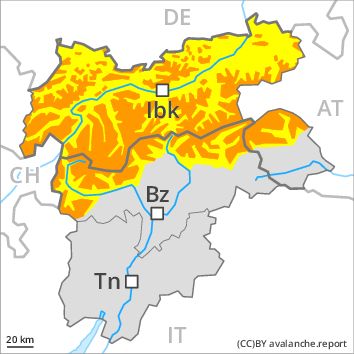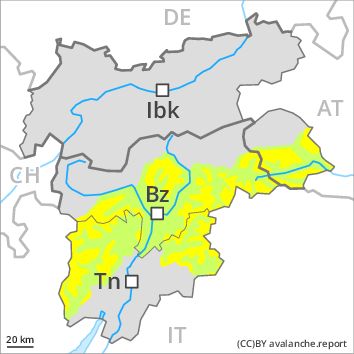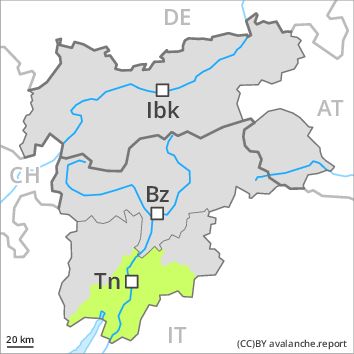Regions
Val Müstair Alps, Western Verwall Mountains, Langtaufers, Eastern Verwall Mountains, Schnals Ridge, Silvretta, Southern Stubai Alps, Samnaun Mountains, Southern Zillertal Alps and High Tauern, Northern Oetz and Stubai Alps, Saldurn-Mastaun Ridge, Western Tuxer Alps, Texel Mountains, Eastern Tuxer Alps, Western Kitzbühel Alps, Western Pfunderer Mountains, Eastern Kitzbühel Alps, Glockturm Range, Eastern Pfunderer Mountains, Durreck Range, Weißkugel Range, Western Rieserferner Mountains, Gurgler Range, Central Stubai Alps, Ortler Range, Northern Zillertal Alps, Allgäu Alps, Venediger Range, Eastern Lechtal Alps - Ammergau Alps, Eastern Rieserferner Mountains, Mieming Mountains, Glockner Range, Karwendel Mountains, Brandenberg Alps, Wilder Kaiser Mountains - Waidring Alps, Western Lechtal Alps, Central Lechtal Alps, Grieskogel Mountains

Danger level
Danger Level 3 - Considerable above the treeline
Danger Level 2 - Moderate above the treeline
Avalanche Problem
Wind-drifted snow above the treeline, N-NE-E-SE-NW
Wet snow above 2600m, SE-S-SW-W

Fresh wind slabs - warming.
The backcountry and freeriding conditions remain to some extent precarious. As a consequence of a strong to storm force northwesterly wind, extensive wind slabs formed in particular in the regions exposed to heavier precipitation. Wind slabs can in some places be released, even by a single winter sport participant and reach medium size. These avalanche prone locations are covered with fresh snow and are therefore barely recognisable, even to the trained eye. Whumpfing sounds and the formation of shooting cracks when stepping on the snowpack can indicate the danger.
Significant warming to high altitudes: As a consequence of warming, the likelihood of loose snow avalanches being released will increase significantly on very steep sunny slopes. In addition as the day progresses an increasing number of small and, in isolated cases, medium-sized slab avalanches are possible. A latent danger of gliding avalanches exists, in particular on steep sunny slopes below approximately 2500 m.
Snowpack
dp 6: cold, loose snow and wind
The snowpack will be subject to considerable local variations. The fresh snow and wind slabs are lying on soft layers, especially on wind-protected shady slopes above the tree line as well as in areas close to the tree line. In some places relatively hard layers of snow are lying on old snow containing large grains.
Tendency
On Sunday as a consequence of the rain there will be a gradual increase in the danger of wet and gliding avalanches.
Regions
Sexten Dolomites, Latemar, Western Deferegger Alps, Ulten Valley, Eastern Nonsberger Alps, Northern Dolomites of Fiemme, Gröden Dolomites, Southern Adamello, Primiero - Pale di S. Martino, Eastern Deferegger Alps, Prags Dolomites, Sarntal Alps, Adamello - Presanella, Schober Mountains, Northern Brenta - Peller, Lienzer Dolomites, Western Nonsberg Alps, Southern Brenta, Fassa Valley, Sole, Pejo and Rabbi, Northern Lagorai, Maddalene

Danger level
Danger Level 2 - Moderate above the treeline
Danger Level 1 - Low above the treeline
Avalanche Problem
Wind-drifted snow above the treeline, N-NE-E-SE-NW
Wet snow above 2600m, SE-S-SW-W

Fresh wind slabs require caution. As a consequence of warming during the day the avalanche prone locations will become more prevalent.
The more recent wind slabs can still be released in particular on steep shady slopes above the tree line. As a consequence of warming during the day small and, in isolated cases, medium-sized moist and wet avalanches are possible. They can be released in the weakly bonded old snow in particular in areas where the snow cover is rather shallow. In particular transitions from a shallow to a deep snowpack where weaknesses exist in the old snowpack are precarious.
Snowpack
dp 6: cold, loose snow and wind
The strong wind has transported the fresh snow significantly. Especially above the tree line mostly small wind slabs formed. Faceted weak layers exist in the snowpack in particular on steep shady slopes. At high altitudes and in high Alpine regions the avalanche prone locations are more prevalent.
Tendency
Gradual increase in danger of dry and moist avalanches as a consequence of warming during the day and solar radiation.
Regions
Prealps, Cembra Valley, Bondone and Stivo, Vallarsa, Folgaria - Laverone, Southern Lagorai, Ledro Valley, Paganella, Marzola - Valsugana, Pine' - Mocheni Valley

Danger level
Danger Level 1 - Low
Avalanche Problem
Wet snow above 2000m, SE-S-SW-W
Wind-drifted snow above the treeline, N-NE-E-SE-S-NW

As a consequence of warming during the day the avalanche prone locations will become more prevalent as the day progresses.
Fresh and somewhat older wind slabs are mostly rather small and can be released by large loads in particular. At high altitudes and in high Alpine regions avalanche prone locations are a little more prevalent. A clear night will be followed in the early morning by quite favourable conditions generally, but the danger of wet and gliding avalanches will increase later. Moist avalanches can be released in near-ground layers in particular in areas where the snow cover is rather shallow. In steep terrain there is a danger of falling on the hard crust.
Snowpack
The snowpack will be in most cases well bonded. The strong wind has transported only a little snow. Adjacent to ridgelines and in gullies and bowls mostly small wind slabs formed. Faceted weak layers exist in the old snowpack in particular on rather lightly snow-covered shady slopes.
Tendency
Temporary increase in danger of dry and moist avalanches as a consequence of warming during the day and solar radiation.



